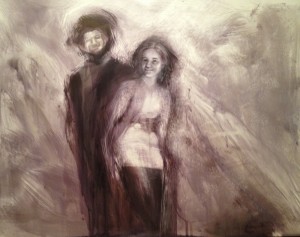I’ve been experimenting with clayboard, an acid free artist grade board with a thin white clay veneer on the top. It’s direct etching, so that the finished piece is the etching, rather than its reflection.
In the drawing above, I used a pen and ink wash to prepare the background, rather than working from a pre-prepared scratchboard (those have a flat veneer of ink over the clay), before scratching into the ink. The drawing’s in progress, as I take a break from sea creatures.
I’m learning as I go. I bought my first scratchboard in an effort to “undo” pen. I wanted the same high contrast that I got with pen on paper, but without the commitment. Draw something. Don’t like it? Scrape it off. I’ve even read it’s possible to add more clay to infill particularly enthusiastic scratching, although I haven’t needed to go to that extreme.
Scratchboard is an ideal project to work on slowly. It retains detail and high contrast without smearing–as charcoal and soft pencil do. I’m told it was first developed for illustrators who wanted a technique to develop high contrast drawings to reproduce. In the days of black and white printers (and poor gradient reproduction), this would have been an ideal medium.
There’s some very good work that’s being done now on scratchboard and clayboard. Have a look at Diane Lee‘s portfolio. She has a beautiful photorealistic still life in the style of an old master, complete with reflections off polished metal and intricate lace. More scratchboard art (and an unusually high proportion of snow leopards) can be found on wetcanvas.com.
The pleasure of the work itself is reason enough for me to continue, even though clayboard is less transportable than my usual pen and ink. It’s changing how I work. The wash enables me to modulate tones without stippling, and I can still scrape back to a white surface, unlike watercolor, where I’d have to premask a region to create white in the final image.
While I like not having to plan my drawings, and I usually didn’t plan my pen drawings, the time commitment involved in finishing a clayboard piece means that I devote much more time creating a mockup to draw from. This grounds the work, making it less dreamlike than my most recent figurative work.
Let me know if you have ideas of tools or techniques that work for scratchboard & clayboards–so far I’ve just been using a blade and ink washes.
